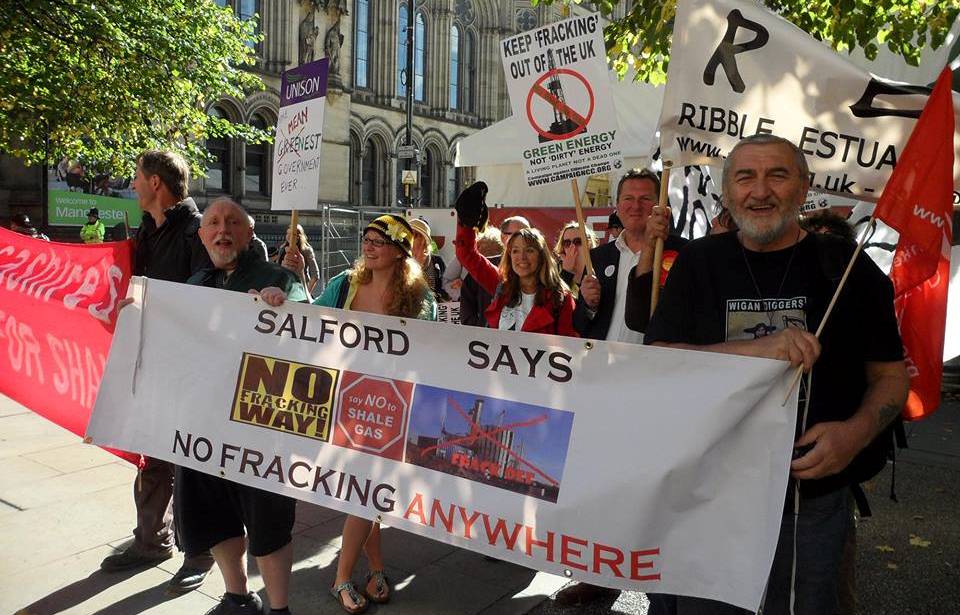Summary
- Fracking focus is shifting to North West
- IGas Energy plan to start drilling soon
- Site at Barton Moss in Salford, near Manchester
- Exploration well targets CBM and Shale Gas
- Drilling threatened to start in mid-November
- IGas are busy fortifying the pad with fencing
- On area of Mosslands known for wildlife
- Growing local opposition as awareness grows
- Resistance being organised by local groups
- Callout for support for across the country
With the activities of fracking company Cuadrilla Resources coming to a temporary halt in Sussex, the focus of UK fracking operations seems likely to shift to another part of the country. Cuadrilla, currently seeking planning permission to conduct “flow testing” of the well at Balcombe, are one of three main fracking companies in the UK. The other two are IGas Energy and Dart Energy, but a number of other companies are following in their wake including Celtique Energie, Coastal Oil & Gas/UK Methane and Third Energy. The next push seems likely to come from IGas Energy who plan to start drilling soon, on farmland at Barton Moss in Salford on the outskirts of Manchester.
IGas’s predecessor, Canadian company Nexen, gained planning permission to explore for coal bed methane (CBM) about 3 years ago, but IGas now intends to drill a much deeper well. This will pass through the coal, at a depth of about 4,500 feet, and continue down through the Bowland Shale to a total depth of about 10,000 feet. This is intended to allow IGas to test for both Shale Gas and CBM with one well. Up until now IGas have mainly been concentrating on one unconventional gas technology (CBM), having drilled a small number of CBM wells near Warrington. However since finding Shale Gas in a well they drilled at Ince Marshes in Cheshire, it has also become involved in Shale Gas exploration as well.

IGas Has Been Erecting Extra Security Fencing At The Fracking Site In Barton Moss (Click To Enlarge)
IGas has just announced that the start of drilling has been pushed back to the middle of November because the company is waiting to receive a permit from the Environment Agency. In the meantime they are busy fortifying the pad against the expecting resistance to this latest fracking threat. This resistance is already growing with public meetings in Irlam and Eccles and a protest outside an IGas Open Day at Salford City Stadium, in the last couple of months. More awareness raising was planned at the Big Moss Birdwatch community event but the Greater Manchester Police managed to intimidate the organisers into cancelling the event. Despite this a number of groups have formed locally including Say No To Fracking On Barton Moss and Frack Free Greater Manchester.
Barton Moss is part of a network of mosslands (peat bog) which includes Chat, Irlam, Barton, Little Woolden and Great Woolden Mosses, and often is collectively referred to as Chat Moss. The moss is a lowland raised bog, formed after the last ice age about 10,000 years ago on the site of a shallow glacial lake. Peat extraction and drainage for agriculture have reduced the unspoiled area of moss to a few remaining fragments, mostly nature reserves. Despite this, the area is home to an enormous variety of wildlife and provides a unique habitat for many plants and insects. In particular the moss is know for the wide variety of birds that it attracts, including some very rare species. Nearby Astley Moss is a Site of Special Scientific Interest (SSSI).
The local area has previously been host to a number of environmental struggles. A battle to halt the continued destruction of the moss by peat extraction which dubbed the moss Salford’s ‘rainforest’, was finally successful in 2012, after a long campaign which included direct action and court cases. Another campaign to stop the building of a waste incinerator nearby is still ongoing, after the government overturned the local council’s rejection of the planning application. This is in some ways part of a wider struggle to defend the greenbelt around Manchester from being gobbled up by relentless development.

Local Groups Who Are Fighting Fracking In Manchester And The Rest Of The North West (Click To Enlarge)
In all these cases the ultimate bad guy is corporate giant Peel Holdings, who own a vast amount of the land in the area, as well as the Manchester Ship Canal and a number of ports and airports. Peel Holdings is the empire of tax-shy billionaire John Whittaker, who lives on the Isle of Man, backed up by the oil money of the powerful Saudi Olayan family. Unsurprisingly Peel also own the land which the fracking site is on, as well as another site just across the Manchester Ship Canal in Trafford for which IGas also has planning permission. In fact Peel appear to be trying to position themselves as the fracking landlords in the North West and are securing land for the exploration and exploitation of coal bed methane (CBM), and probably now shale gas.
Coincidentally the drilling rig that was being used by Cuadrilla to drill the Balcombe well was bought by its owners, Meehan Drilling, to service their drilling contract with IGas. It therefore seems quite likely that the rig will soon be heading to Barton Moss to drill IGas’s well. There are a few other drilling rigs in the country that IGas could potentially be used, but the Meehan rig used at Balcombe is by far the most likely. This well is just the thin end of a very large wedge, that could see thousands of wells drilled across the region. See our article Fracking The North West: The Latest Front Line? for more information. Meanwhile people are getting organised to resist. The Northern Gas Gala event has being organised, with a callout for people to converge on the site from 9am on the 27th November.

.JPG)

